Thomas Hill Standpipe
Introduction
Text-to-speech Audio
Images
Illustration of the Thomas Hill Standpipe, provided by bangorwater.org
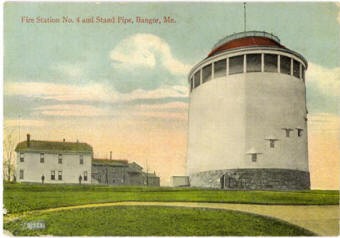
The Thomas Hill Standpipe in winter, provided by bangorwater.org
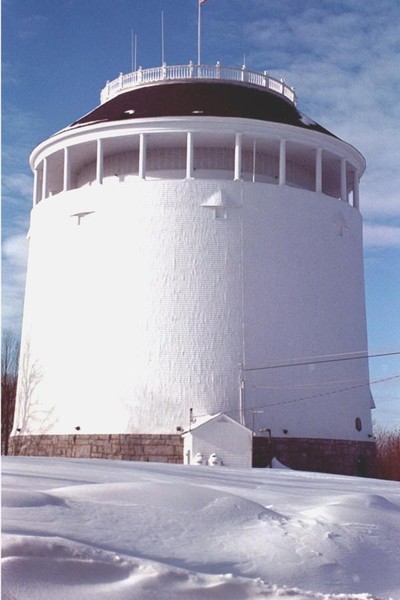
An illustration of the Thomas Hill Standpipe, provided by bangorwater.org
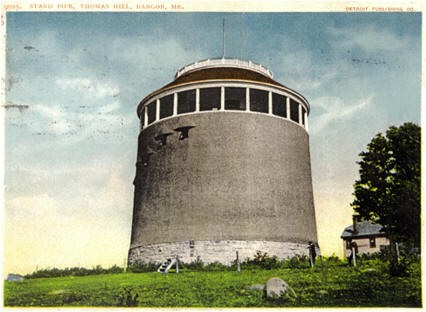
Undated photograph of the Thomas Hill Standpipe, provided by bangorwater.org
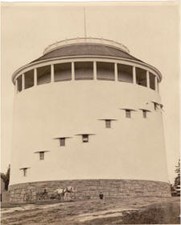
1957 photograph and newspaper clipping of the Standpipe, under repair, provided by bangorwater.org

Photograph of the Standpipe under construction, provided by bangorwater.org

Collage of Photographs of the Standpipe, provided by bangorwater.org
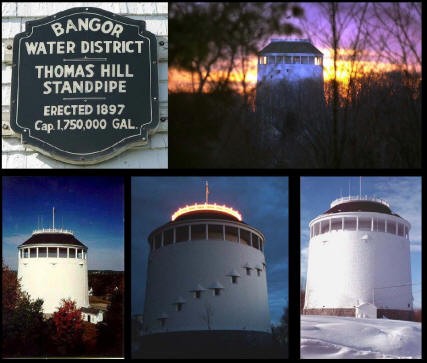
Backstory and Context
Text-to-speech Audio
The Thomas Hill Standpipe towers above the City of Bangor, standing 110’ tall. The iconic structure is actually two separate constructions: the water reservoir itself, and the enclosing observation tower. Between the outer wall of the reservoir and the outer wall of the observation tower winds a long stairway that leads to the upper floor of the tower, which is a 360-degree visibility observation deck approximately 80 feet in diameter.
The vast majority of the Standpipe was built using hard pine, though the beautiful exterior shingles were crafted from cedar wood, which was locally sourced by two Bangor lumber firms. The Thomas Hill Standpipe was designed in the Shingle style of architecture, which was largely developed and popularized by famous Portland architect John Calvin Stevens. John Calvin Stevens’ influence on the architectural history of the State of Maine is unrivaled, and he is largely credited with creating the image of New England residences that fills the imagination of so many travelers from around the world.
The Standpipe was unique even among Shingle style buildings, which were mostly residences, and drew the attention of contemporary commentators. The construction of the Standpipe took approximately six months, during which time contractor Major James M. Davis established a portable sawmill and a Blacksmith shop on site to expedite the construction efforts.
The Thomas Hill Standpipe is a registered National Historic Landmark, an American Water Works Association Landmark, and a historic landmark of the American Society of Civil Engineers. It is beloved by locals and is a common leisure location, the surrounding fields and park being ideal for recreation of various types. During open houses, it is regularly visited by locals and tourists alike, being a favorite spot of both professional and amateur photographers looking to capture the incredible views of the City of Bangor only possible from the Standpipe.Sources
NPS NRHP Official Documentation for the Thomas Hill Standpipe. National Park Service. Accessed August 19, 2017. https://npgallery.nps.gov/pdfhost/docs/NRHP/Text/74000185.pdf. Official documentation for the Thomas Hill Standpipe Nomination onto the NRHP
Bangor, Maine. bangormaine.gov. Accessed August 19, 2017. http://www.bangormaine.gov. Official Website for the City of Bangor Municipal Government
Bangor Water. Bangorwater.org. Accessed August 19, 2017. http://www.bangorwater.org/whats%20new%20home/schedule.htm. Information on the visitation schedules, photographs, and historical information provided by the organization that manages the water tower
